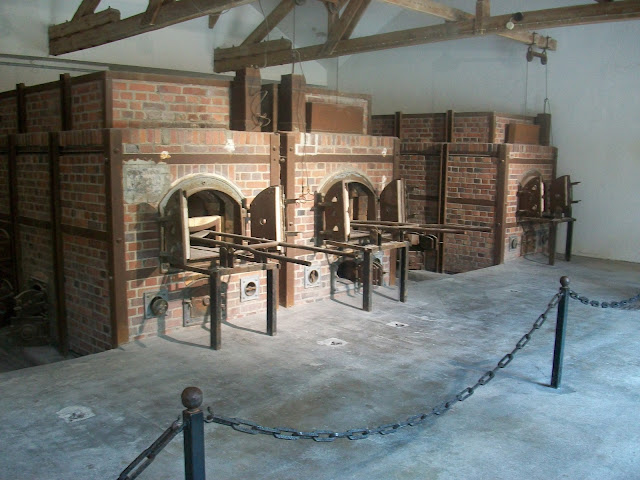Things we learned about Dachau Concentration Camp:
It was the only camp open for all 12 years of Hitler's reign. It was also one of the first and considered a "model" camp. Many practices were tested here first before being implemented at other camps.
The camp was not built from the ground up, it was originally an old Army Munitions factory from World War I. It was used as a work camp for the Nazis, then as a camp for Nazi prisoners, and then it was a refugee camp until the 1960s, when it became a memorial site.
The entrance into Dachau, original building from the 1930s, called the Jourhouse.
The inscription on the gate "Arbeit Macht Frei" means "Work sets you free" in English. The gate is a reconstruction. You are looking at the Roll Call Square beyond it.
When it was very first opened it was possible for a short time to actually be set free based on the work you performed. This was limited mostly to a few immigrants who promised to leave Germany and never return.
There is only one known successful escape attempt from Dachau which occurred in 1933, the year it first opened. No one knows how it was accomplished because the escapee refused to give details that would incriminate the help he received from the outside.
The Roll Call Square and the Maintenance building. You can see the jourhouse to the far right. (This was a panorama shot on our camera and the proportions might be a bit off.) The Maintenance building housed things practical to the camp - showers, kitchen, laundry as well as processing rooms for new prisoners.
The back of the Maintenance building and a Bunker to the right. This bunker housed "special" prisoners, special meaning either better or worse treatment for you.
The inside. A few of the more well-treated (though that term is used loosely) prisoners include members of royalty as well as Catholic priests. The priests were actually allowed to mingle outside of their cells as well as hold mass together. This building also housed prisoners set apart to be especially punished. It had rooms for torturing prisoners as well as standing cells - rooms so tiny the person was not able to sit or lie down.
Looking towards the front of the camp. The bunkers were originally built to last only 10 years or so, but were actually used for about 30 years. Obviously by that time their condition was bad enough they were not able to save any of them, but there are two reconstructed ones at the front of the path.
A reconstruction of the original bunks from the Munitions factory. See the shelves? Prisoners were still allowed to bring small personal items when the camp was first opened.
Those were later replaced with these style bunks for a short time.
And then these were the bunks used for the majority of the time.
The crematorium. The prisoners who worked here also slept here so that it was kept completely separate from the main camp.
A beautiful memorial to show where the ashes were buried. There were two other locations with plaques on them. The sign says "Grave of Thousands Unknown."
The door into the gas chambers. "Brausebad" translates to "shower-bath" in English. This was located in the same brick building as the crematorium.
The inside of the chamber. Although Dachau did construct this gas chamber, it was only used twice - to test it. I believe historians are still unsure why it was never officially used.
Officially, Dachau was considered a "work" camp, not a "death" camp, although of course many men died from the effects of their imprisonment. Many others were sent to those considered "death" camps to be killed in the gas chambers there.
Obviously there is more I could write, but these are the facts I didn't know and considered interesting, as well as specific to Dachau. It was a very sobering day but I feel lucky that I had the chance to see it in person.














I don't know if you know this, but I did one stint as a research assistant at byu and I was contacted by a woman in florida, last name klages, whose father was in dachau. she wanted me to look up papers in the special collections of a doctor who entered with the allies the day dachau was discovered. I got to see first hand photos taken that day as well as journal accounts from people seeing dachau for the first time who never believed it existed. it was pretty interesting and so of all the concentration camps, I remembered dachau the most. thanks for the pictures. and also thanks for updating on the details. ive enjoyed reading these posts! blogspot wouldn't let me comment on your last post :(
ReplyDelete